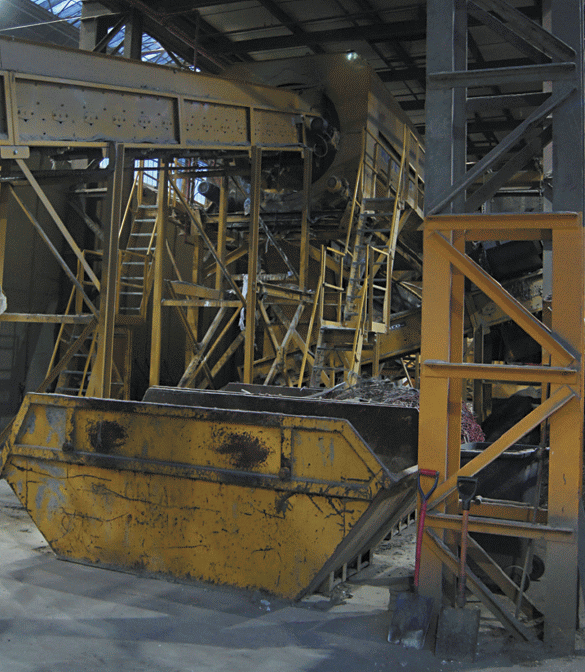 Glass is one of the most productive materials in terms of recycling potential, because it can be recycled over and over again without loss of quality or integrity. However equipment used to handle the material can suffer from the effects of extreme abrasion, a problem one recycling facility managed to solve through the use of Kingfisher Industrial’s K-TEX rubber lining system
Glass is one of the most productive materials in terms of recycling potential, because it can be recycled over and over again without loss of quality or integrity. However equipment used to handle the material can suffer from the effects of extreme abrasion, a problem one recycling facility managed to solve through the use of Kingfisher Industrial’s K-TEX rubber lining system
According to the figures from the British Glass Manufacturers Association, recycled glass is present in around 55 per cent of UK-produced glass products sold in UK outlets. This reveals that there is still ample scope for higher levels of recycling, which is important when one considers that every tonne of recycled glass returned to production saves 322kWh of energy, 246kg of CO2 and the requirement to quarry and ship 1.2 tonnes of virgin raw materials.
Achieving higher levels of glass recycling is an objective dependent upon a number of factors including the reliability of plant in which the recycling process takes place. Militating against this is the major problem with handling glass: its high level of abrasion. Glass is aggressive, both in terms of its inherent hardness characteristics and in the quantities and velocities at which it is conveyed. Consequently, equipment used to handle the material can suffer from the effects of extreme abrasion, which, if not addressed, can result in costly, unexpected downtime.
The solution is wear protection: the process of coating or lining plant and equipment, particularly such close-to-process items as transfer chutes, pneumatic pipework, cyclones, separators, hoppers, screens and crushing plant, with ceramics, metallics or polymers to extend their life.
 The economic case for wear protection is clear, because, in many applications, the benefits of protecting plant are threefold. In addition to protecting against wear and extending plant life, the low friction nature of the lining material reduces energy usage and increases production by allowing a greater volume of material to be throughput.
The economic case for wear protection is clear, because, in many applications, the benefits of protecting plant are threefold. In addition to protecting against wear and extending plant life, the low friction nature of the lining material reduces energy usage and increases production by allowing a greater volume of material to be throughput.
To these benefits should also be added reduced maintenance. “Our field experience and calculations show that it is far more profitable for companies in process industries to employ wear protection at plant inception, rather than having to provide regular maintenance and repair of equipment at regular intervals due to problems associated with wear and erosion,” says John Connolly, MD of wear protection specialist, Kingfisher Industrial. “Reduced maintenance means reduced risk, reduced cost and more production uptime over longer periods.”
A key advantage of wear protection is it can be employed at any time in the life of process equipment. Moreover, because high conveying speeds and abrasive materials cause wear of varying intensity at different points in handling systems, it is often the case that protection need only be applied to areas of plant that are most vulnerable to wear, further reducing upfront costs and improving ROI for the system user.
However, if a process system is designed with wear protection from its inception, then overall equipment costs can often be reduced as the system chosen to protect the equipment can often alleviate the requirement to manufacture components using heavier grades of material. In addition, involving a wear specialist such as Kingfisher at the design stage of process conveying equipment can streamline the design, optimising process efficiency through reduced turbulence and improved material flow, at the same time ultimately delivering improved service life.
A recent application at a UK recycling facility underlines the benefits. The plant operators had employed an OEM to install a system that separated different fragmentations of glass and then removed all paper and fibre contamination, enabling the glass to be sold to glass recycling companies. The system exceeded all expectations, with regard to being able to produce various fractions of clean glass that could be recycled, as opposed to being sent to landfill. The only issue was that the cleaning system, consisting of exhaust ducting and cleaning cyclones, wore out after a few weeks, due to the amount of sub-micron glass and sand contamination that was being conveyed during the pneumatic extraction process.
Kingfisher was contacted, and offered a suitable system, which involved protecting the plant using Kingfisher’s K-TEX rubber lining system. This system, which has been in service for over three months, was recently inspected and there were no signs of wear or degradation evident throughout the installation. This is due to special characteristic of the K-TEX liners that counter wear by absorbing, and then repelling, the energy of the conveyed media. Despite the sharp and angular shapes of the fragments, the liners, having a hardness of 60 shore A, have proved to be more than resilient in combating the aggressive nature of the highly abrasive conveyed media.
Kingfisher Industrial
T: 01384 410777


